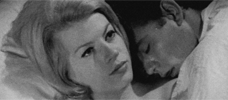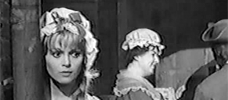Reviews
Reviews Bosomania!: The Sex, the Violence, and the Vocabulary of Russ Meyer

Beneath the Valley of the Ultravixens
Russ Meyer
USA, 1979
Credits
Review by David Carter
Posted on 11 September 2008
Source RM Films International VHS
Categories Bosomania!: The Sex, the Violence, and the Vocabulary of Russ Meyer
Confused? There’s no need to be. It’s really a rather simple story.
—The Man From Small Town USA
In a 1996 interview with the UK magazine Flesh & Blood, Meyer stated that Beneath the Valley of the Ultravixens was his favorite of his own films. He made this statement without a hint of hesitation, even correcting the interviewer who had posited that it would be Supervixens! Such a definitive statement from any artist would warrant a deep analysis of the work in question, but the statement means far more coming from Russ Meyer. Meyer held fast to his own artistic vision in every work, refusing to compromise for Twentieth Century Fox or even a changing marketplace. When he singles out Beneath the Valley of the Ultravixens above his other films, one can only assume that it holds some special quality, some piece of Meyer’s vision that his other works fail to capture.
A recitation of the plot would give the impression that Beneath was little different from the standard Meyer fare, yet bear in mind that - as is often the case with his work - the true merits of the film are more readily seen in the execution. Gorgeous Lavonia Shedd is sexually unsatisfied by her husband Lamar, who is only interested in anal sex. The film’s narrator, The Man From Small Town USA, politely refers him to as “a rear window man.” Lamar’s “problem” lands him in two unfortunate situations: firstly, it causes him to lose his job at the junkyard when his boss Sal finds out he is a “prevert [sic].” More importantly however, it causes Lavonia to seek satisfaction with other men. She has trysts with garbage man Mr. Peterbuilt, the teenage stud Rhett, and most notably with door-to-door lingerie salesman Semper Fidelis. Fidelis provides Lavonia with a sexy dress and a wig that allow her to perform at a local strip club under the guise of Lola Langusta, a Mexican stripper. Lamar’s inability to recognize his own wife under a wig (The Man From Small Town USA informs us that Lamar’s IQ is a paltry 37) motivates Lavonia/Lola to drug him in an attempt to acclimatize him to vaginal sex. This gambit fails, as does a visit to dentist/marriage counselor/homosexual Asa Lavender. Lamar finally turns to local radio faith healer Eufaula Roop to cure his problem once and for all and to hopefully save his marriage.
The narrator is a carryover from Up! but its use here is far more effective. Rather than providing the plot as in the previous film, The Man From Small Town USA merely comments on the film as it unfolds, adding another layer of color to the already vibrant story. Actor Stuart Lancaster will be a familiar face to Meyer fans, and his casting here has more meaning than just another of Meyer’s stock actors. Lancaster appears in six Meyer films, and the argument could be made that he is essentially the same character in at least three of those: Mudhoney, Supervixens!, and this film. He became as prominent a fixture in Meyer’s work as the rotating cast of large-chested women, but Lancaster is the static, stoic counterpoint to these beautifully volatile women—here, the literal “Man From Small Town USA” that Meyer imagined himself to be, and perhaps more importantly, imagined his audience to be. Lusty sex kittens would lose their meaning in a world where such behavior was the norm, and Lancaster provides a bedrock of normalcy and plainness against which their beauty and sexuality is juxtaposed. In Beneath the Valley of the Ultravixens, The Man proposes that there is a Lavonia/Lola lurking in every small town. He is as mesmerized by her actions as the audience is, however, proving that she is anything but common.
Beneath shows a renewed interest in subtlety after the extremes explored in Up! Meyer still exceeds the nudity and sexuality of his previous works but stops short of the quasi-hardcore of the latter film. Commonalities exist between the two, though, particularly Meyer’s use of montage and quick edits. Beneath the Valley of the Ultravixens constantly assaults the viewer with the edits to the point that are less of a gimmick and more a style in and of themselves. Portions of Beneath are essentially slide shows comprised of still photographs shown in succession. Meyer shows us these “photographs” with such speed as to give them movement and meaning, breaking down each scene into a jigsaw-like series of single frames the viewer must assemble into the whole image. This is particularly true for Kitten Natividad’s Lavonia, who is rarely shown in full view but in extreme close ups. Pubis, breasts, eyes—she is an assemblage of parts rather than a whole corporal being. This dissection is not intended to demean but to celebrate her, however. Lavonia is epitome of feminity, an unreachable standard of beauty of whom every part is worth celebrating. Meyer is almost implying that to show her completely would be too much for the audience to handle, so he’s broken her down into more readily digestible parts.
Sound and technology are recurring themes in Meyer’s work, but in Beneath the Valley of the Ultravixens the two become vital parts of the narrative and the mise-en-scene. Meyer uses the parabolic microphone extensively in our introduction to Lavonia and Lamar. Her desperation for his attention is displayed through the soundtrack’s amplification of her most infinitesimal movements. Her lazy playing with her pubic hair sounds like thunder on the soundtrack and provides an explanation of their relationship dynamic more efficiently than any verbal exposition could. The parabolic microphone also comes into play as part of Eufaula Roop’s “healing” of Lamar, and it can be seen as part of Meyer’s use of technology as a metaphor in the film. We are first introduced to Eufaula as she is playing a game of Pong while being serenaded by Martin Bormann on an electric player piano. Next, Lavonia’s thunderous motions are used contrapuntally against the beeps and blips of Lamar’s pocket calculator. Those who use such modern technologies are shown as being somehow flawed, unnatural. Lavonia is depicted as having reached the depths of despair when she turns to a battery-powered vibrator for satisfaction, which is then shown as more offensive to Lamar than her extramarital affairs. The simple, less-modern life is portrayed as more desirable through the vintage cars driven by the characters and the fact that the primary form of entertainment is still the radio rather than television. Meyer’s Ludditian metaphor is extended by the fact that each of the gadgets (Pong, the calculator) is shown as being a distraction from his preferred form of entertainment: sex.
Beneath the Valley of the Ultravixens has an uncharacteristically happy ending; it lacks a “villain” so all the characters are shown prospering in the end. The Man From Small Town USA appears to provide a summation of the film’s events and, to a degree, of all of Meyer’s films. Sex is at the center of all life in Small Town America. Not in a lascivious or crude manner, but a pure one: sex as an expression of love and joy. In Meyer’s world, it is sex that is the real driving force in America, not religion, politics, or capitalism. The Man From Small Town USA turns the film over to Meyer himself for the final thoughts, and he recounts the tale we’ve just heard and gives us the true story and final fate of his favorite Nazi, Martin Bormann. He then beckons Natividad (calling her by her real name) to follow him out of the desert and muses, “Where is the crew?” One of the final shots is Meyer trudging up the hillside alone, camera on his shoulder.
This shot would be the last true image of Meyer’s feature film career. The promised The Jaws of Vixen previewed thereafter never materialized; neither did several other equally provocative titles such as The Bra of God to name but one. Meyer would direct a piece on busty star Pandora Peaks for Playboy, but it was little more than a documented photo shoot. Thus the image of the man alone with his camera stands as Meyer’s final contribution to the world of cinema. Meyer’s black clad frame cuts an imposing figure against the dull browns of the California desert, in much the same way his iconoclastic films made an indelible impression on American cinema. In this image, he is literally taking his camera and going home, his work concluded but his impact eternal.
More Bosomania!: The Sex, the Violence, and the Vocabulary of Russ Meyer
-

The Immoral Mr. Teas / Eve and the Handyman
1959 / 1961 -

Lorna
1964 -

Fanny Hill
1964 -

Mudhoney
1965 -

Faster, Pussycat! Kill! Kill!
1965 -

Motor Psycho
1965 -

Mondo Topless
1966 -

Common-Law Cabin
1967 -

Good Morning and… Goodbye!
1967 -

Finders Keepers, Lovers Weepers!
1968 -

Vixen!
1968 -

Cherry, Harry & Raquel!
1970 -

Beyond the Valley of the Dolls
1970 -

The Seven Minutes
1971 -

Black Snake
1973 -

Supervixens!
1975 -

Up!
1976 -

Beneath the Valley of the Ultravixens
1979
We don’t do comments anymore, but you may contact us here or find us on Twitter or Facebook.


